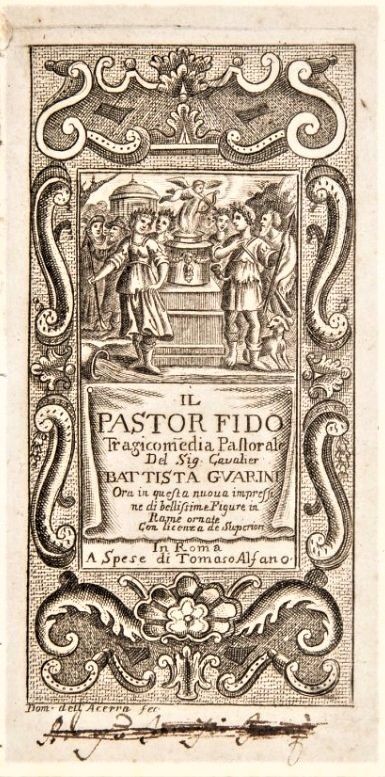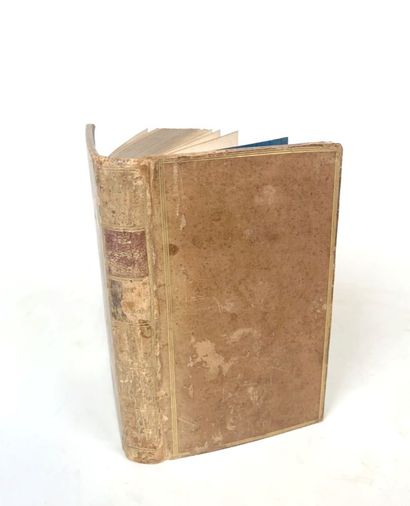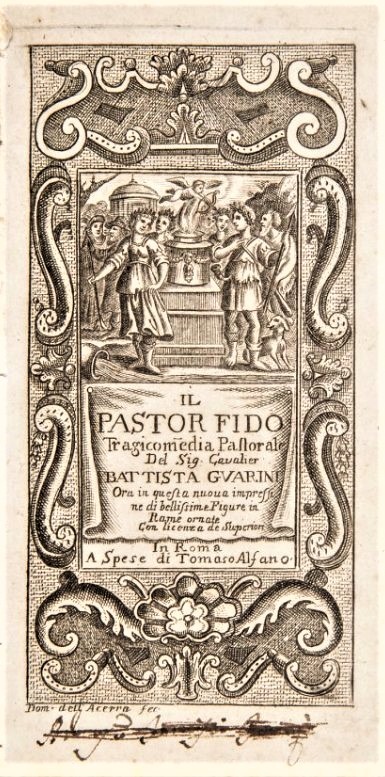Guarini, Giovanni Battista Il pastor fido, Tragicommedia pastorale. Del molto Illustre Sig. Cavaliere Battista Guarini. Ora in questa XXVII. impressione di curiose, & dotte annotationi arricchito, & di bellissime figure in rame ornato. Con un Compendio di poesia tratto da i due Verati, con la giunta d’altre cose notabili. Venice: Giovanni Battista Ciotti, 1602
Large-paper copy of Guarini’s celebrated pastoral (first edition Ferrara: Benedetto Mamarello, 1590), here enhanced by full-page engravings of costume and scenery. The edition is dedicated by the publisher to Vincenzo Gonzaga, who had staged the play in Mantua in 1598 during celebrations there of the marriage of Margaret of Austria and Felipe III of Spain. According to Adriano Cavicchi, the costumes and stage-sets for that performance may be represented in the series of six engravings. Ciotti’s numbering of his editions is incomprehensible: three editions were issued by him in quarto format in 1602, one as “XX. impression” and two as “XXVII impression” (one of the latter paginated, the other foliated). The “XXVII impression” is said by Dennis E. Rhodes to be a corrected reissue of the preceding (Giovanni Battista Ciotti [Venice, 2013], no. 240). Ciotti’s edition of 1606 is designated “XXX impressione”; however, one of 1625 is again numbered “XXVII. impressione”.
The present copy, printed on large paper, and bound in ivory vellum, has the arms of Henri IV and crowned H in the corners and in compartments of the spine. An identical binding covers a copy of Vincenzio Panciatichi, Gli Amori affanni, favole pastorale ([S.l.]: G.B. Ciotti, 1606; Vienna, Österreichische Nationalbibliothek, BE.10.W.69 ALT EINB), and it is possible that the King chose to have his pastorals bound in this manner. An undated, but contemporary, inscription records that it was a gift from Jacqueline de Bueil, Comtesse De Moret (1588–1651), to Daniel Dumonstier (1574–1646). The Comtesse was a mistress to Henri IV in 1604–1608, and Dumonstier, the King’s Peintre et Valet de Chambre (appointed 1603). The copy is recorded in an inventory of Dumonstier’s possessions, made on 6 November 1628 following the death of his first wife. If the book was not gifted while both the Comtesse and Dumonstier were at court, it perhaps happened in July 1626, when Dumonstier drew her portrait. The volume later passed into the library of the Prince du Soubise.
There are apparently two distinct editions of this “twenty-seventh impression” of the Pastor fido, one paginated, the other foliated, and the sheets in some copies are a mixture of the two; Rhodes observes that “The bibliography of Guarini around this period defies all logical explanation, and is complicated beyond belief” (p. 180). This large-paper copy is foliated, and the “Compendio di poesia” is not included.
4to (235 x 169 mm). Italic and roman types, lines variable. collation: a-b8 A-Z8 Aa-Gg8 Hh4: 260 leaves. Title printed within an engraved historiated border, engraved portrait of the author by Lucas Kilian (1579–1637), 6 full-page engravings (1 signed by Francesco Valesio fl. 1598-1624), each imposed with the letterpress, numerous woodcut initials and typographic ornaments. (Bound without the “Compendio di poesia” called for on the title-page, scattered marginal soiling.)
binding: Parisian flexible ivory vellum (238 x 174 mm), ca. 1602, for Henri IV, outer frame composed of a gilt French fillet with a crowned “H” at inner corners, inner frame composed of a gilt French fillet, fleuron at outer angles, branch of feuillage at inner corners, in center crowned arms of Henri IV with motto “Manet vltima cælo,” traces of 2 pairs of fabric ties, flat spine, 6 false bands of double gilt fillets, alternating crowned “H” and gilt fleur-de-lis in compartments, edges gilt. (Lower fore-edge corner bumped, lightest soiling.)
provenance: Henri IV, King of France (1553–1610 [r. 1589—1610]; armorial supralibros) — Jacqueline de Bueil, Comtesse De Moret, given to — Daniel Dumonstier (inscriptions “Ce livre est a Daniel Du Monstier Et lui a esté donne par Madame la Comtesse de Moret” on title-page and folio 256 verso; inventory taken by the booksellers Cramoisy & Duval for the notary Simon Le Mercier, following the death of Dumonstier’s (first) wife: “Inventaire après décès de Geneviève Ballifre, décédée le 6 novembre 1628, dressé à la requête de Daniel Dumonstier peintre et valet de chambre du roi et de la reine”: “Item pastor fido del g[u]*arini relié en velin”, valued 40 sols, transcribed from the document in the Archive nationales by Daniel Lecoeur, Daniel Dumonstier 1574–1646 (Paris, 2006), pp. 226–232 (p. 229) — Armand Gaston Maximilien, Cardinal, prince de Rohan (1674–1749; purchased former’s library in 1706, shelfmark on upper pastedown) — Charles de Rohan, prince de Soubise (1715–1787; shelfmark on upper pastedown [not traced in his 1789 sale, compare lot 5293, different edition in small format]) — Jean Fürstenberg (1890–1982; Jean Fürstenberg, Le Grand siècle en France et ses bibliophiles (Hamburg, 1972), p. 40 and Dia 1) — Fondation Fürstenberg-Beaumesnil, Beaumesnil [Mesnil-en-Ouche] (Wemaëre-de Beaupuis-Denesle Enchères SARL & Binoche et Giquello, Paris, 9 December 2013, lot 180). acquisition: Purchased at the Fondation Fürstenberg-Beaumesnil sale through Robin Halwas.
references: USTC 4035216; for the engravings, see Cavicchi, “La scenografia dell’Aminta nella tradizione scenografica pastorale ferrarese del sec. XVI,” in Studi sul teatro Veneto fra Rinascimento ed età barocca, a cura di Maria Teresa Muraro (Florence, 1971), pp. 53–72 (pp. 59–60).
Guarini, Giovanni Battista Il pastor fido, Tragicommedia pastorale. Del molto Illustre Sig. Cavaliere Battista Guarini. Ora in questa XXVII. impressione di curiose, & dotte annotationi arricchito, & di bellissime figure in rame ornato. Con un Compendio di poesia tratto da i due Verati, con la giunta d’altre cose notabili. Venice: Giovanni Battista Ciotti, 1602
Large-paper copy of Guarini’s celebrated pastoral (first edition Ferrara: Benedetto Mamarello, 1590), here enhanced by full-page engravings of costume and scenery. The edition is dedicated by the publisher to Vincenzo Gonzaga, who had staged the play in Mantua in 1598 during celebrations there of the marriage of Margaret of Austria and Felipe III of Spain. According to Adriano Cavicchi, the costumes and stage-sets for that performance may be represented in the series of six engravings. Ciotti’s numbering of his editions is incomprehensible: three editions were issued by him in quarto format in 1602, one as “XX. impression” and two as “XXVII impression” (one of the latter paginated, the other foliated). The “XXVII impression” is said by Dennis E. Rhodes to be a corrected reissue of the preceding (Giovanni Battista Ciotti [Venice, 2013], no. 240). Ciotti’s edition of 1606 is designated “XXX impressione”; however, one of 1625 is again numbered “XXVII. impressione”.
The present copy, printed on large paper, and bound in ivory vellum, has the arms of Henri IV and crowned H in the corners and in compartments of the spine. An identical binding covers a copy of Vincenzio Panciatichi, Gli Amori affanni, favole pastorale ([S.l.]: G.B. Ciotti, 1606; Vienna, Österreichische Nationalbibliothek, BE.10.W.69 ALT EINB), and it is possible that the King chose to have his pastorals bound in this manner. An undated, but contemporary, inscription records that it was a gift from Jacqueline de Bueil, Comtesse De Moret (1588–1651), to Daniel Dumonstier (1574–1646). The Comtesse was a mistress to Henri IV in 1604–1608, and Dumonstier, the King’s Peintre et Valet de Chambre (appointed 1603). The copy is recorded in an inventory of Dumonstier’s possessions, made on 6 November 1628 following the death of his first wife. If the book was not gifted while both the Comtesse and Dumonstier were at court, it perhaps happened in July 1626, when Dumonstier drew her portrait. The volume later passed into the library of the Prince du Soubise.
There are apparently two distinct editions of this “twenty-seventh impression” of the Pastor fido, one paginated, the other foliated, and the sheets in some copies are a mixture of the two; Rhodes observes that “The bibliography of Guarini around this period defies all logical explanation, and is complicated beyond belief” (p. 180). This large-paper copy is foliated, and the “Compendio di poesia” is not included.
4to (235 x 169 mm). Italic and roman types, lines variable. collation: a-b8 A-Z8 Aa-Gg8 Hh4: 260 leaves. Title printed within an engraved historiated border, engraved portrait of the author by Lucas Kilian (1579–1637), 6 full-page engravings (1 signed by Francesco Valesio fl. 1598-1624), each imposed with the letterpress, numerous woodcut initials and typographic ornaments. (Bound without the “Compendio di poesia” called for on the title-page, scattered marginal soiling.)
binding: Parisian flexible ivory vellum (238 x 174 mm), ca. 1602, for Henri IV, outer frame composed of a gilt French fillet with a crowned “H” at inner corners, inner frame composed of a gilt French fillet, fleuron at outer angles, branch of feuillage at inner corners, in center crowned arms of Henri IV with motto “Manet vltima cælo,” traces of 2 pairs of fabric ties, flat spine, 6 false bands of double gilt fillets, alternating crowned “H” and gilt fleur-de-lis in compartments, edges gilt. (Lower fore-edge corner bumped, lightest soiling.)
provenance: Henri IV, King of France (1553–1610 [r. 1589—1610]; armorial supralibros) — Jacqueline de Bueil, Comtesse De Moret, given to — Daniel Dumonstier (inscriptions “Ce livre est a Daniel Du Monstier Et lui a esté donne par Madame la Comtesse de Moret” on title-page and folio 256 verso; inventory taken by the booksellers Cramoisy & Duval for the notary Simon Le Mercier, following the death of Dumonstier’s (first) wife: “Inventaire après décès de Geneviève Ballifre, décédée le 6 novembre 1628, dressé à la requête de Daniel Dumonstier peintre et valet de chambre du roi et de la reine”: “Item pastor fido del g[u]*arini relié en velin”, valued 40 sols, transcribed from the document in the Archive nationales by Daniel Lecoeur, Daniel Dumonstier 1574–1646 (Paris, 2006), pp. 226–232 (p. 229) — Armand Gaston Maximilien, Cardinal, prince de Rohan (1674–1749; purchased former’s library in 1706, shelfmark on upper pastedown) — Charles de Rohan, prince de Soubise (1715–1787; shelfmark on upper pastedown [not traced in his 1789 sale, compare lot 5293, different edition in small format]) — Jean Fürstenberg (1890–1982; Jean Fürstenberg, Le Grand siècle en France et ses bibliophiles (Hamburg, 1972), p. 40 and Dia 1) — Fondation Fürstenberg-Beaumesnil, Beaumesnil [Mesnil-en-Ouche] (Wemaëre-de Beaupuis-Denesle Enchères SARL & Binoche et Giquello, Paris, 9 December 2013, lot 180). acquisition: Purchased at the Fondation Fürstenberg-Beaumesnil sale through Robin Halwas.
references: USTC 4035216; for the engravings, see Cavicchi, “La scenografia dell’Aminta nella tradizione scenografica pastorale ferrarese del sec. XVI,” in Studi sul teatro Veneto fra Rinascimento ed età barocca, a cura di Maria Teresa Muraro (Florence, 1971), pp. 53–72 (pp. 59–60).














Testen Sie LotSearch und seine Premium-Features 7 Tage - ohne Kosten!
Lassen Sie sich automatisch über neue Objekte in kommenden Auktionen benachrichtigen.
Suchauftrag anlegen